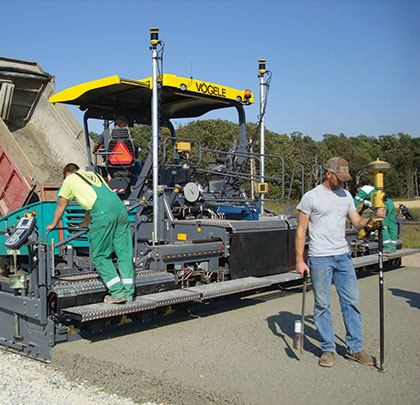Automated grade control technologies provide a passing grade
The recent construction of a short stretch of a state highway in northeast Arkansas that required no stakes or stringlines provided a glimpse into the future of grade control. The project also utilized automated grade control technologies on some machines that are relatively new to them. And now the rest of the story from Full-Depth Grade Control…
Trench Safety & Supply, Inc., North Little Rock, Arkansas, and representatives from Topcon Positioning Systems equipped a Gomaco 9500 dirt trimmer with a Millimeter GPS+ automated grade control system to fine-grade the subgrade.
In addition to a GNSS base and rover, the 3D system uses a PZL-1 Lazer Zone transmitter and a PZS-MC machine-control sensor or PZS-1 rover sensor that gets integrated with the contractor’s GNSS receiver. The PZL-1 transmitter sends out a wall of laser light 33-feet tall and up to 2,000 feet in diameter. The contractor can link up to four transmitters and the PZL-1 transmitter can operate multiple machines equipped to accept its signals. The GNSS component of the system plots the location of the machine, while the laser component guides the grader to position and elevate the blade precisely. The system calculates the vertical angle from the laser up to the sensor on the machine and gives a vertical correction to the GNSS system, allowing quarter-inch accuracies.
The system trimmer on Highway 67 had dual sensors for elevation control on both sides of the machine. The system also provides automated steering for width control. The GNSS coordinates and laser beam were processed by the machine’s G21 controller, which guided the machine. In one pass, the trimmer dug out several inches of dirt from the subgrade using an auger and teeth-equipped trimmerhead located on the underside of the machine, near the front. Trimmed dirt was placed onto the shoulder using the trimmer’s long conveyor located at the back of the machine.
The automated grade control system also was used on a Vögele Super 2100-2 paver, which was used to install the Cement Stabilized Crushed Stone Base (CSCSB) layer at a width of 30 feet. Existing survey data from trimming work was available for use by the Vögele paver, which otherwise paves asphalt. These unique machines are designed to pave in great width for significant highway work productivity using a wide auger system on the front of the machine and a vibrating screed. Another boon to productivity is the machine’s high-compacting screed option, which Weaver-Bailey is using on this project. The screed has tamper bars that oscillate at high frequency, compacting the CSCSB almost completely and to a much greater extent than other pavers. The high compaction limits the number of passes to one.
This was the first such machine to be equipped with a Topcon automated grade control system in the United States; automated grade control has been used on Vögele Super Series pavers in Europe several times. The automated grade control system used on the machine controlled steering, as well as the elevation of the CSCSB surface; the tolerance was plus or minus ¼ inch.
The Vögele paver was equipped with the manufacturer’s Navitronic Plus, a built-in 3D open interface/open port system that is compatible with commercially available automated grade control systems. The automated grade control system on the machine includes two Navitronic Plus operating consoles for the screed, dual masts for mounting the 3D receivers, an angle sensor for the mast, and sensors for picking up displacement of the screed’s extending units. The sensors on the two extending units pick up the screed’s width; the machine is reportedly the only paver on the market with automatic screed extension control.
The Millimeter GPS+ system sent commands to the Navitronic Plus system to move the machine left, right, up, or down. The operator views the model on an in-cab GX-60 controller. While the system hardware is interchangeable for the different machines that Weaver-Bailey is operating on the job, the software was configured to fit each machine. ■
About The Author:
Don Talend, Write Results Inc., West Dundee, Illinois, is a print and e-communications content developer specializing in covering construction, technology, and innovation.
_________________________________________________________________________
Modern Contractor Solutions, April 2013
Did you enjoy this article?
Subscribe to the FREE Digital Edition of Modern Contractor Solutions magazine.

Topcon’s Millimeter GPS+ System


